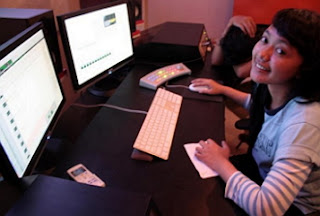Beraudiovisual’s friends, are you need to put a home studio to record the voice for home videos, indie/independent productions, film and more?
Do you have a computer with a sound card that can act as your DVR? Just add a little low-cost equipment and recording software on your PC, and can produce high quality recordings of voice easily and efficiently. What other equipment do you need?
Microphone.
To get your voice on your computer, you need a microphone. Do not use a bit of shit comes with your computer. High quality abundant cheap microphones and sound much better than that crap. For work in basic votes, I suggest that SM58 Shure SM57 is or. They are rugged, dynamic microphone that sounds good. The SM58 is ideal for female voice, as it reduces wheezing (Esses excessive) in some way. Men can choose from. The two microphones are available from music or audio equipment suppliers for less than Rp. 850.000. Also, get a microphone cable and a desktop computer a good position to hold the microphone while speaking.
Mic preamp.
Microphones put a small amount of electricity that the signal must be amplified. Sound card microphone preamplifier includes necessary. Unfortunately, like the cheapo mic that comes with the box, most of the mic preamps sound card is too noisy for serious work. If necessary you can use, but at least use a better microphone.
For the preamp, you can choose a small mixer to work with your microphone or a dedicated unit. Mixers essentially allows to connect several microphones and other devices (like a CD player) in one location and adjust their volumes independently. The Behringer mixer EURORACK MX602A between 6 microphone inputs, level control, and cost less than Rp. 500.000 Alternatively, two good choices for stand-alone mic preamps include DBX mini pre-tube preamp and the ART Tube MP Studio V3 preamp. Both are under Rp. 1.000.000 and available from the same sources mentioned above.
If you do not invest a lot of high-quality recording microphones, faulty, and your computer's audio interface. Two better choices are mic. For the purposes of pre-amplifier, select a device interface and preamp combination of audio, such as equipment Duo Edirol UA-5 or M-Audio.
Speakers and headphones.
While your computer speakers are adequate for recording, editing and finishing of basic laptops built to serve no purpose. Invest in some decent powered speakers, such as the Roland MA-8 micro monitors, and use them instead. Play back your recordings on a variety of stereo systems, car, etc. to control how they could be transferred to other environments. You can not listen to the speakers when you save, because they receive feedback when the microphone is on. Wear closed-ear noise that keeps leaking them to be picked up by the microphone.
Recording software.
Choose recording software with editing facilities to correct errors, the compilation of the best pieces, add music and / or sound effects, creating special effects, and deliver your finished voice tracks in the formats you need. A "light" version of a program of professional recording is Sonic Foundry, Sound Forge Studio.
Recording space in silence.
Its aim is to record a track clear, intimate voice, and that means keeping noise and the sound of the room outside the recording is finished. Professional recording in a sound booth specifically designed to keep noise and the sounds they make beautiful voice. These costs thousands of dollars and are a little more realistic for informal work. An article full, walk-in works as a taxi of his fortune, however.
Getting a good
The basic integrated sound card has three connectors: Mic-in, line and the line (or headphones) to the outside. Connect the device to connect the microphone to the mixer (or preamp), and connect the device to the output of the line sound card Connect the headphones, too. (If you have dedicted external interface that plugs into that. E 'connected to a computer via a USB port.)
Next, set the volume to a mixer (or preamp), using the controls and level meters. Start talking, watch his feet, and slowly turn up the volume until you get to almost 0 (zero), without going over.
Start the software that controls your sound card (it's usually the little speaker icon in the system tray). This is where you choose your recording source (LINE IN) and adjust its volume. Put this on 100% all the way up, and check your recording levels with your external mixer or preamp.
Start with audio recording software and get ready to save. Records mono, not stereo and CD quality (16 bit and 44kHz sample rate). You will notice that the audio software is not set the level of control, but do not rely on the meters when recording. Never, never more than 0 (zero) to a digital level meter. All this above the level of the distorted sound bad. He wants all the loud noise would fall below 0 for most digital well below the level (between -6 - 15 dB).
Mic technique
Greatly improve the sound recordings, closer to the microphone. The farther away from you, the more you earn the room around you. Your voice sounds thin and distant, like a movie at home. Closer, and your voice is intimate, the voice of the narrator prototype. Another advantage is closer to the microphone, you can increase the lower frequencies in your voice, and that can make the sound more powerful. How close? Put your lips 4-6 inches apart, about the width of your hand. Do not speak into the microphone. Instead, the position above the nose pointed down to his lips. Also, do not place the mic dead center of the lips. Move slightly to the right, for example, 20 degrees off axis. This leaves a clear understanding of the script, too.
Of course, finding their area of registration of any aircraft noise, such as computer fans. Put some distance between the microphone and the noise source. Also, avoid salty foods immediately before the recording session. It takes a little close to the warm water and apply some lip balm. They keep the mouth and lips lubricated. Eating a few slices of apple can help overcome the dryness of the mouth, too.
When you are ready to save, turning away from the microphone. Take a deep breath. Exhale. Take another deep breath. Open your mouth, back to the microphone and begin speaking. This technique eliminates the net consumption of smell and lip breathing, which often occurs when you start talking.
Speak slowly and clearly. You can always increase the recording during the editing stage. If you make a mistake, return to the closest phrase to start again and continue, even if you only one or two voice errors. Cut in a voice or phrase is difficult and does not seem natural.
Editing Records

There is no need to nail all in one take. Record the highest number of run-through, and the need to assemble the best of the last recording. Listen and evaluate what you did. Everything is there that you need? Sound good? It is the right level (not too low, does not distort)? Otherwise, go back and re-record the bits you need, listen, and repeat until you are satisfied.
Change the sound is like editing a voice processing program. You will not see the voices, but you can not see two-dimensional presentation of voices as sound waveforms. And you can hear the voices while playing. You can manipulate the waveforms as a move from voices on the Voice Processor. Cut, copy, paste all the techniques you're already familiar with the subject during audio editing.
Before you start editing, turn off the microphone, disconnect the headphones, speakers and go. It 'clear, to remove what is not necessary, as a clear his throat before he started talking, no talking between takes, strange voices, and so on. After removing the waste, to move towards improved performance. If you have several companies in the script, finding the best takes and build the last version of them.
Listen to the fundamental changes they make. I think that taking a long break, you can approach the records again with fresh ears. You can do better? The volume is constant? Do you hear noise, background noise or other unwanted parts could be eliminated or reduced?
After editing the voice, you can add sound effects or music to soften the last version. To add music with Sound Forge, open the music file on your audio software, select and copy to the clipboard. You may have to cut the music to match the duration of the voice recording in the first place. Next, place the cursor at the beginning of the voice recording and select Edit; Paste special blend. "Here you can control the level of the music (source) in connection with his voice (target). Ensure that the mixture again to ensure that you can listen to the recording of voice clearly with the background music.
As a last step, the use of software standardization process to maximize the volume of the audio recording. Select the entire signal and normalization of -0.10 dB (98.86%). Save this file in audio format you need, for example, MP3.
Now, you are ready to have a great voice over!



4 comments:
Pertamax sahabat :) tumben nih saya jd yg pertamax ^_^
matappp!!!
komen sana sini. komen back. http://ari-software.blogspot.com/
Terimakasih atas kunjungannya agan agan... nanti akan segera sya kunjung balik. terimakasih :D
Terus belajar ya ,.. menarik tuh ..
Post a Comment